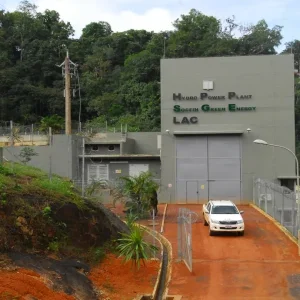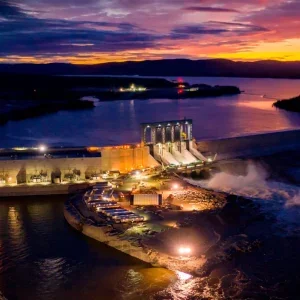There are a number of situations in which data on the cavitation performance of a turbine are needed. These include commissioning a new unit or after refurbishment or an overhaul in which turbine parts, like runner blades or wicket gates, are modified or repaired. During normal operation it is also useful and important to know if there are changes in a turbine’s cavitation behaviour caused by various deterioration effects.
The only way to assess the intensity of cavitation in an operating turbine and get an insight into its condition is to listen to cavitation. Cavitation produces a vibro-acoustic field which is transmitted from water to the turbine’s dry side and conveys information on the cavitation flow and the erosion it causes. Numerous experiments have shown that structure-born sound and high frequency vibrations of turbine parts provide a kind of cavitation ‘fingerprint’.
The simplest way to describe cavitation by vibro-acoustic means is to put a vibro-acoustic sensor in a suitable location on the turbine and measure the intensity of noise within an appropriate frequency band, count the rate of noise pulses which reflect the pulse nature of turbine cavitation, or compare noise spectra collected at different power settings. The first choice is to use mean values of these quantities as cavitation intensity estimators but, although this approach is widely used, it is not optimal. Figure 1 illustrates two drawbacks of the mean value method. The peaky modulation curves were recorded by 12 sensors mounted around the runner of a 60MW Kaplan turbine (the solid lines denote the sensors’ locations). By relying on simple mean values, valuable data on the role of turbine parts contained in such curves are ignored. And by using only one sensor, a fully erroneous description of cavitation may be obtained. Different forms and amplitudes of the estimates of the cavitation intensity distribution over the turbine parts are obtained in different locations.
Multi-dimensional algorithm
The multi-dimensional approach to turbine cavitation assessment that differs substantially from the mean value one was developed at korto-cavitation-services through a series of prototype tests and research. The method has been proven and used in practice on Francis, Kaplan, and bulb type turbines, and was presented at the iahr Symposium on Hydraulic Machinery and Systems in August 2000. The multi-dimensional method consists of a unique way of collecting, processing and interpreting the vibro-acoustic data expressed as a function of the sensor’s location, noise frequency, runner instantaneous angular position and the degree of turbine loading. The method can be used in two ways:
• As a measurement, analysis and interpretation tool in multi-dimensional in-plant diagnostic tests of turbine cavitation.
• As the basis of the signal and data processing algorithm in multi-dimensional cavitation monitoring systems.
Korto Cavitation Services uses the method as a standard tool for both applications. In a typical diagnostic test a huge amount of data is collected and used: more than 40GB of vibro-acoustic data measured with 20 sensors within the frequency range from the revolution frequency to 1MHz, each parameter or function averaged over 100 revolutions, everything performed at 20 turbine power settings and analysed circumferentially with a resolution of 0.2°. These diagnostic tests can provide detailed descriptions of cavitation.
A special implementation of the method minimises the disturbance of a normal unit’s operation during the tests but still furnishes such data records so cavitation can be virtually reproduced and all conceivable types of analysis can be performed later in the laboratory. If permanent monitoring is found to be necessary, the resulting cavitation description is then used to define the tailor-made monitor which has less sensors and manipulates with less data, but is still able to detect any important irregularities in the turbine concerned.
The way the modulation curves are treated in the multi-dimensional method is illustrated by figure 2. Two cavitation mechanisms identified in a 17MW Francis turbine are described by the two upper plots. The variation of the cavitation intensity is shown in a normalised form, so that the mean value equals one. As it can be seen, there is no modulation in the signals generated by mechanism 1 (upper figure), while a collection of strongly pronounced peaks appears in the turbine power and noise frequency ranges related to mechanism 2 (middle figure). Although these patterns are apparently chaotic, a strict order rules them. The bottom figure shows how the data are used to assess the role played by different runner blades and guide vanes. One of the steps used to identify and assess different cavitation mechanisms that may be functioning in a turbine are illustrated by the 3D plots in figure 3.
There are several further data processing steps in the multi-dimensional algorithm. The most detailed results they yield are:
1) The fine structure cavitation characteristic of a turbine which specifies the intensity of cavitation related to each runner blade/guide vane pair.
It can have two forms, ie be related to:
(a) The total cavitation intensity in the turbine. (b) Each of the cavitation mechanisms functioning in it.
Less detailed results are:
(2) The runner cavitation characteristic that shows how intensive the cavitation is related to each runner blade.
(3) The wicket gate cavitation characteristic – the same for each guide vane.
The least informative but nonetheless useful result is:
(4) The global cavitation characteristic of the turbine which specifies the total cavitation intensity for a given turbine power setting.
The characteristics (2)-(4) can also have both forms, (a) and (b). It has to be noted that each of (2)-(4) is packed in a single 3D or 2D graph or function for each mechanism or the total cavitation, while the characteristic (1) is a collection of the 3D graphs or functions, one for each turbine power setting tested.
Some examples describing the 17MW Francis turbine with 19 runner blades and 20 guide vanes are shown in figure 4.
Only one sample of the fine structure characteristic is presented, the one related to the power value at which the total cavitation intensity reaches its maximum. All the characteristics are given in the (a) form, except for the global characteristic which is shown also for the four cavitation mechanisms identified in this particular turbine. There are a number of ways to use the results from the multi-dimensional method. Three of them are illustrated by examples of the cavitation characteristics of the Francis unit considered above.
Cavitation diagnosis
Multi-dimensionally derived turbine cavitation characteristics (accompanied by some additional results of the multi-dimensional tests not discussed here) present the description of cavitation, the information content of which reaches the theoretical limit: all relevant turbine parts are characterised and the cavitation mechanisms are identified. This latter issue may be very helpful. In the example illustrated in figure 4, it made the estimation of the erosion rate possible; at the present state of development the vibro-acoustic methods alone do not suffice to realise this crucial task.
It was deduced that as the turbine operates almost all the time at 16-17 MW, mechanism 3 shown in the global characteristic (see figure 4, 4b) is responsible for erosion. Additional data have shown that mechanism 3 is related to the guide vanes. The data on metal used in repairs of these and the vibro-acoustically derived quantity proportional to the erosion rate for mechanism 3 resulted in a fully calibrated erosion rate estimate.
Turbine repair
In the Francis unit considered, runner blades do not differ much (see figure 4, 2a), but there are very high differences in cavitation intensity related to different guide vanes (figure 4, 3a). Differences between neighbouring vanes reflect differences in their individual cavitation quality. These can result from differences in vane profile shape or non-optimal angular settings of the vanes. The multi-dimensional method cannot explain the cause of the low cavitation quality of a particular vane but it can show which vanes have to be inspected and repaired, and can be used to check repairs.
Operation optimisation
The global cavitation characteristic (figure 4, 4a and 4b) is well-suited for optimising plant operation with respect to cavitation. Indeed, depending on power demand, more or less conservative limits for cavitation intensity may be set and the range of turbine loading in which cavitation intensity passes these limits can be avoided.
If there are two or more turbines in a plant, limits have to be set for all of them. For each turbine, cavitation characteristics have to be determined individually since even supposedly identical turbines can display significantly different cavitation behaviour. This holds true even for newly-installed turbines and certainly does for turbines that have been in operation for some time. When the water supply is inadequate for full power plant operation, the optimised operation strategy has to specify which turbines should be used and at what loading.
Cavitation monitoring
The graphs (see figure 5) illustrate the advantages of a multi-dimensional monitor. They show the monitor’s output for three cases of the monitoring algorithm, each based on a different cavitation characteristic: 1) Fine structure characteristic – resolution with respect to both runner blades and guide vanes; 2) runner characteristic – resolution with respect to runner blades only; and 3) global characteristic – no resolution with respect to turbine parts. The outputs obtained in two different states of the turbine are shown (see figure 5) one above the other: the regular state (green), and after some damage appeared (red). The arrows point to the parts of the curves where the change should be observable.
The change was detected only by means of the most powerful algorithm (1), and the simplest form of the monitor, the one based on the total cavitation intensity (4) was far from noticing anything. All three algorithms are built in the multi-dimensional monitor, while most other monitors realise only the algorithm (4).
Conclusion
The new multi-dimensional method for vibro-acoustic diagnostic in-plant tests and monitoring turbine cavitation, developed at Korto Cavitation Services, was successfully used to:
• Identify turbine parts that are responsible for cavitation.
• Identify different cavitation mechanisms that appear in a turbine.
• Derive detailed cavitation characteristics of a turbine which incorporate resolution with respect to turbine parts and cavitation mechanisms.
• Set up cavitation monitoring systems that have exceptionally high sensitivity with respect to deterioration effects in the early phases of development.
The method differs from most cavitation monitors in the fact that it resolves turbine parts and cavitation mechanisms. It is capable of the following:
• Enables optimisation of turbine operation with respect to cavitation.
• Shows how a turbine’s cavitation behaviour can be improved.
• Forms the basis of a highly reliable cavitation monitoring system.
Related Articles
Spotlight on … uprating and refurbishment






